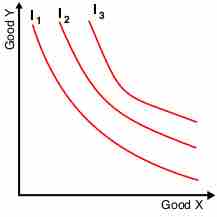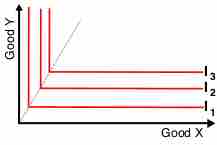A critical input to understanding consumer purchasing behaviors and the general demand present in a given market or economy for specific goods and services is the identification of consumer preferences. Consumer preference varies substantially from individual to individual and market to market, requiring comprehensive economic observation of consumer choices and behaviors. One of the primary tools leveraged by economists mapping consumer preferences is the indifference curve, which illustrates a series of bundled goods in which a consumer is indifferent. A consumer would be just as happy with any combination of Good X and Good Y on the curve . This could synonymous to saying baskets of goods that provide the same utility.

Indifference Curve
A consumer will be just as happy with any combination of Good X and Y on indifference curve I1, though s/he will prefer any bundle on indifference curve I2 or I3.
These indifference curves, when mapped graphically alongside other curves, is called an indifference map. A key consideration in creating any indifference map is what relative preferences should be isolated. While it is possible to create a complex array of preference maps to compare more than two products/services, each specific standard indifference map will be about creating a benchmark between two. For example one could compare relatively similar goods/services (i.e. apples vs. oranges) or dramatically different goods/services (i.e. university training vs. automobile purchasing). These two items being compared represent the x and y axis of a indifference map. A consumer will always prefer to be on the indifference curve farthest from the origin.
Implications of Indifference Maps
After constructing the required inputs to generate a comprehensive indifference map, an economist can derive conclusions based upon the properties of the illustration. In framing these implications it is useful to identify the two potential extremes that can be outlined via with indifference curves:
- Perfect Substitutes: To understand what a indifference curves will look like when products are perfect substitutes, please see . These lines are essentially perfectly straight, and that demonstrates that the relative utility of 'Good X' compared to that of 'Good Y' is equivalent regardless of the amount in question. It is reasonable to assume in this scenario that purchasing all of one or all of the other will not decrease the overall satisfaction of the consumer. Perfect substitutes are often homogeneous goods. A consumer with no preference between Burger King and McDonald's, for example, might consider them perfect substitutes and be indifferent to spending all of their fast food money on one or the other.
- Perfect Complements: The opposite of a perfect substitute is a perfect complement (see ), which is illustrated graphically through curves with perfect right angles at the center. These right angles, and the subsequent straight horizontal and vertical lines, demonstrate that 'Good X' and 'Good Y' are inherently tied to one another and that the consumption of one is dependent upon the consumption of the other. An example of complementary goods might be university tuition and academic textbook purchases, an automobile and automobile insurance, or a cable and a television.
Combining an understanding of these inputs with the extremes demonstrated an indifference map, economists are able to draw meaningful conclusions regarding consumer choices and purchasing behaviors in the context of two goods. The comparison between the goods demonstrates the relative utility one has compared to another, and the way in which consumers will act when posed with a decision between various products and services.

Perfect Substitute Indifference Curve
In this particular series of indifference curves it is clear that 'Good X' and 'Good Y' are perfect substitutes for one another. That is to say that the utility of one is identical to the utility of the other across all quantities represented on the map.

Perfect Complement Indifference Curve
The perfect right angle in this series of indifference curves implies that the utility of 'Good X' and 'Good Y' are entirely interdependent. This is to say that in order to enjoy one good it is necessary to also have the other.